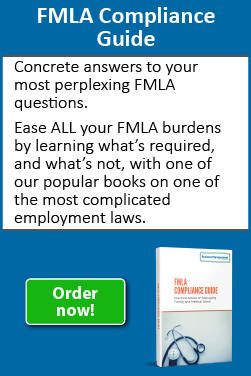FMLA Leave for Baby Bonding
Work-life balance is a key concern for all employees in this day and age. Employees want to be able to build a fulfilling career while also starting a family and being present for their children. But what happens when your employees need time off to bond with a new bundle of joy?
That’s where the FMLA comes in. The Family and Medical Leave Act (FMLA) provides eligible employees the ability to take work leave for the birth, foster care placement, or adoption of a child and to bond with the child. Workers can also take FMLA leave for their own serious health condition and to act as a caregiver for a family member with a serious health condition (including pregnancy).
FMLA baby bonding leave is a bit different from other forms of FMLA leave in terms of administration. It’s important that employers understand their rights and responsibilities when managing this type of FMLA leave so that the leave process runs smoothly and employees are able to access the time off and protections that they are entitled to. We’ve compiled some of the key considerations to help employers understand how to handle an FMLA baby bonding leave request.
What is FMLA baby bonding leave?
The Family and Medical Leave Act is a federal law that grants employees up to 12 workweeks of job-protected, unpaid leave for qualifying reasons related to family responsibilities or serious health conditions. During the leave period, employees continue to receive health insurance (and all other applicable health benefits) if they were enrolled in an employer-sponsored plan. At the end of their leave period, they must be reinstated to an equivalent role with equivalent pay and benefits.
In the case of baby bonding leave, the purpose is to allow new parents time to bond with and care for their newborn child or newly placed child. This bonding leave isn’t exclusive to traditional birthing experiences, there are actually three circumstances where employees may take family bonding leave under the FMLA:
-
Baby bonding after the birth of a child. The most common form of FMLA family bonding leave is traditional baby bonding leave which takes place after the birth of a child. Eligible employees can take up to 12 weeks within a 12-month period to bond with their new child.
-
Bonding with an adopted child. Employees may also take time off to bond with a newly adopted child, even if they were not adopted at birth. As long as the child is a minor, a legal adoption will generally qualify for FMLA leave for family bonding. For FMLA purposes, the Department of Labor (DOL) defines adoption as legally and permanently assuming the responsibility of raising a child as your own.
-
Bonding with a foster child. Employees who foster children, regardless of whether or not the child is biologically related to the employee, may also use family bonding FMLA leave. For FMLA purposes, foster placement is defined as 24-hour care for children in substitution for, and away from, their parents or guardians. There is no minimum placement period required for FMLA leave for foster care, so leave may be used for short-term emergency placements or respite care as well as long-term placements (though the employee should alert their employee if circumstances related to their need for FMLA leave substantially change during their leave and the foster child is removed from their care earlier than expected)
FMLA baby bonding leave eligibility requirements
Both parents may take FMLA leave for baby bonding. Some employers incorrectly believe that baby bonding leave is limited to mothers, but fathers are also eligible. The one exception is married spouses that work for the same employer, who are eligible for a combined total of 12 weeks of leave which they may split between themselves. Unmarried employees working for the same employer can still take twelve weeks of leave each. In addition, FMLA family bonding leave is not limited to biological children.
The general eligibility requirements for FMLA leave do still apply. Employees that request FMLA leave will need to meet the following requirements:
-
Have worked for their employer for at least 12 months (not necessarily consecutively).
-
Clock in at least 1,250 hours of service with the employer during the prior 12 months.
-
Work at a location where a covered employer has at least 50 employees within 75 miles (unless working for a covered educational or public agency).
Of note for baby bonding leave, these minimum service requirements need to be met before the employee takes leave. However, they do not need to be met during the pregnancy or by the baby’s birth date. Employees that are ineligible for leave at the time of birth can still use their 12 weeks once they hit the 12-month and 1,250-hour mark as long as all other conditions are met, and they are still within the first year of the child’s life or placement.
When Can Baby Bonding Leave Be Taken?
FMLA leave for baby bonding can be taken at any time during the baby’s first year of life. Though employees should provide their employers with at least a 30-day notice when the need for leave is foreseeable (of course, employers will need to be somewhat flexible with the dates as babies are often born off-schedule). Many new parents space out their leave so that one parent is home with the newborn for the first twelve weeks and then the other begins their leave, so don’t be surprised if an employee’s FMLA request does not perfectly coincide with the birth of their child.
If family bonding leave is being taken in relation to the placement of a foster child or adoption, leave can be taken within the first year of placement. Some leave may also be used prior to the adoption being finalized if the employee needs time off for required counseling, court dates, attorney meetings, or other eligible appointments.
While most forms of FMLA leave can be taken as intermittent leave, employers have more of a choice in how FMLA baby bonding leave is taken. They may choose to allow employees to take family bonding leave on a reduced schedule or intermittent basis, but they are not required to unless other conditions are met.

Documentation of family relationships
In most cases of FMLA leave, employers have the opportunity to request a medical certification completed by a health care provider However, employers may not request a traditional certification form for FMLA baby bonding leave or family bonding leave when a child has been placed for adoption or foster care. Similarly, medical documentation or a fitness-for-duty certification cannot be required when an employee returns to work from family bonding leave.
What employers can ask for is reasonable documentation of a family relationship. To meet this requirement, the employee should provide the employer with a simple writ
ten statement or a copy of an official document, such as a child’s birth certificate or a court document, to verify the presence of a legally-recognized family relationship.
FMLA baby bonding leave vs FMLA pregnancy leave
The FMLA covers several different types of leave covered including medical, caregiving, pregnancy, and family bonding. While they all fall under the category of “FMLA leave”, there is a difference between leave taken for pregnancy and leave taken for baby bonding.
Leave taken for pregnancy is typically considered medical leave under the FMLA and can require medical certification documentation. Pregnancy may be considered a “serious health condition” under the FMLA, and pregnant people may take time off while incapacitated from pregnancy symptoms such as morning sickness, gestational diabetes, or other pregnancy complications or illnesses. They may also take time off to go to medical appointments. This is often taken as intermittent leave throughout the pregnancy, though some expecting parents will need time off at the end of their pregnancy if bed rest is ordered by their doctor.
As discussed above, baby bonding leave is not tied to a specific medical need. Instead, it is for bonding with the new addition to your family.
Regardless of the technical differences in how these two leave types are defined and managed, they are still both forms of FMLA leave and still count towards the total 12 weeks of FMLA leave allowed under FMLA regulations within a 12-month period. Though as with any employment law matter, it’s a good idea to check your state laws. Some states have separate paid family leave laws or protections like the California Family Rights Act (CFRA) that offer time off for pregnancy complications. Pregnancy Disability leave (PDL) is also available in some states or through some short-term disability insurance programs.
Additional resource: Read more about FMLA requirements and what they mean for your business.







